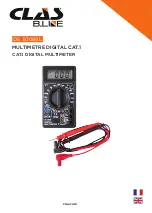
4
•
The central beam should be treated with a mix of linseed oil and white spirits every 6-12 months, (or
more often depending on circumstances) – this will help to repel water and prevent waterlogging of
the central beam which can be a source of measurement errors.
•
Always use the white mud caps and grommet to keep mud away from the probe mounting position
under the beam or wing.
•
Take special care to fit all the insulators as shown in the diagrams – if the metal probes conctact with
the wooden or metal wings potential leakage current paths can be created which in turn can cause
measurement errors, especially in wet weather.
•
Touch up any scratching of paint on the wings to avoid any possible current tracking to or from
exposed metal.
•
Ensure the bolts securing the handle to the beam (located underneath the beam) are still encapsulated
with plastic filler and rubberised sealant.
•
When using wings ensure the nylon bush and washer kit that insulates the struts from the handle has
not broken.
•
If you experience striping problems with Parallel Twin data you may wish to follow the practice of
some users who wrap heavy duty plastic sheeting around the beam system and seal it up with tape.
This is reported to greatly reduce or eliminate striping problems, especially in older frames.
Striping Defects with the Parallel Twin Configuration
Even with good care and maintainance, striping can still occur with the Parallel Twin mode, usually in wet
conditions. Normally, all will be well when the weather is fine but after a short period of working in rainy
conditions or in long damp grass striping will start to occur. Typically this is a low level phenomenon, about 2
ohms in magnitude. Two example surveys illustrate this problem and show two different methods of dealing
with the error should it arise.
Method 1
An example of striping can be seen in the survey opposite, figure 1. The first image is the raw data, and the
second shows the data after high pass filtering (X=10, Y=10, Wt=U) so the striping is clearer. The survey is an
amalgam of surveys made with Single Twin and 2 Parallel Twin (3 probe), with the striping occurring only
with the 2 Parallel Twin configuration.
The data can be corrected using standard Geoplot process routines applied to the complete composite. First the
data must be despiked and saved. Then apply a low pass filter across the saved data with X=10, Y=0,
Wt=Gaussian. Repeat the low pass filter 3 or 4 times and save this new data set. Low pass filtered data for the
raw data above (not the high pass filtered data set) is shown in figure 2. This new data set has effectively had
most archaeological features smoothed out and retains just the background geology and striping defect due to
leakage.
Next subtract this new data set from the original despiked data set to effectively remove the striping defect. You
can see from the results in figure 3 that all trace of the striping has been removed. Note also that the data has
effectively been high pass filtered, though there are differences from the regular high pass filtered data in that
localised features are more visible. Note that any archaeological features that are parallel with the traverse
direction will be removed by this processing technique, so, depending on their importance, you may need to use
the Cut and Combine function to temporarily store and preserve such features in a temporary composite and
then repaste them back in their original positions after the above processing.


























